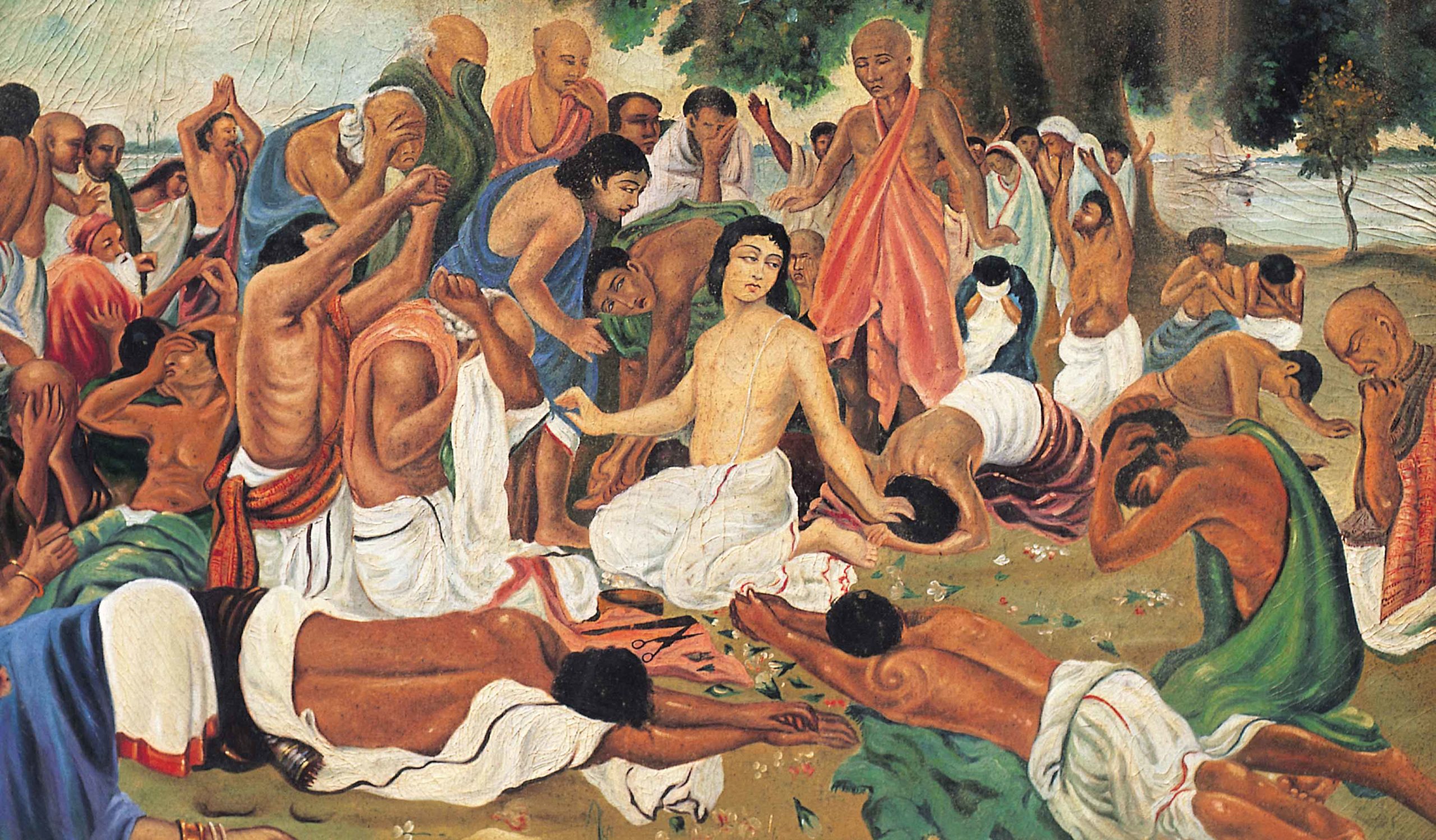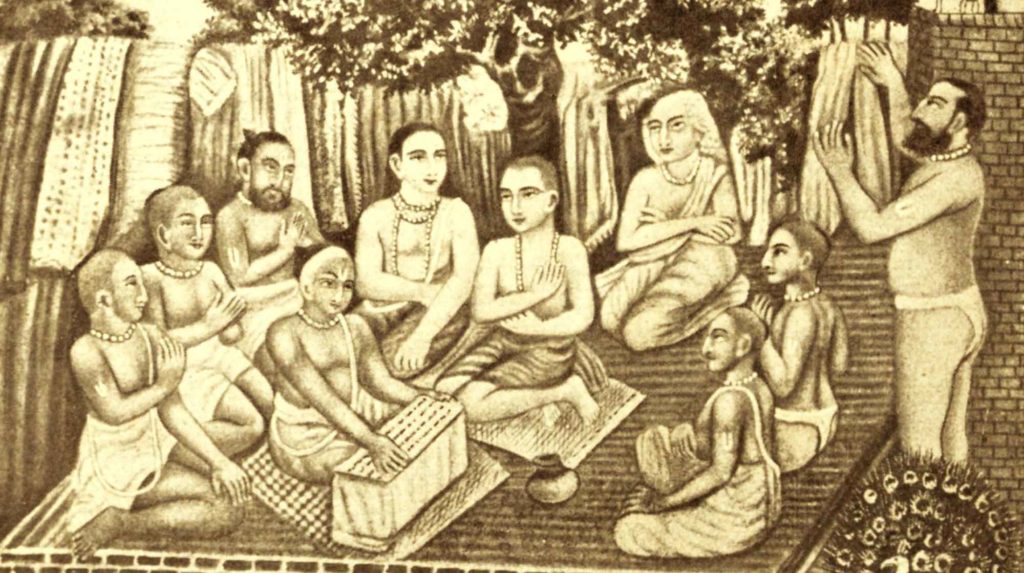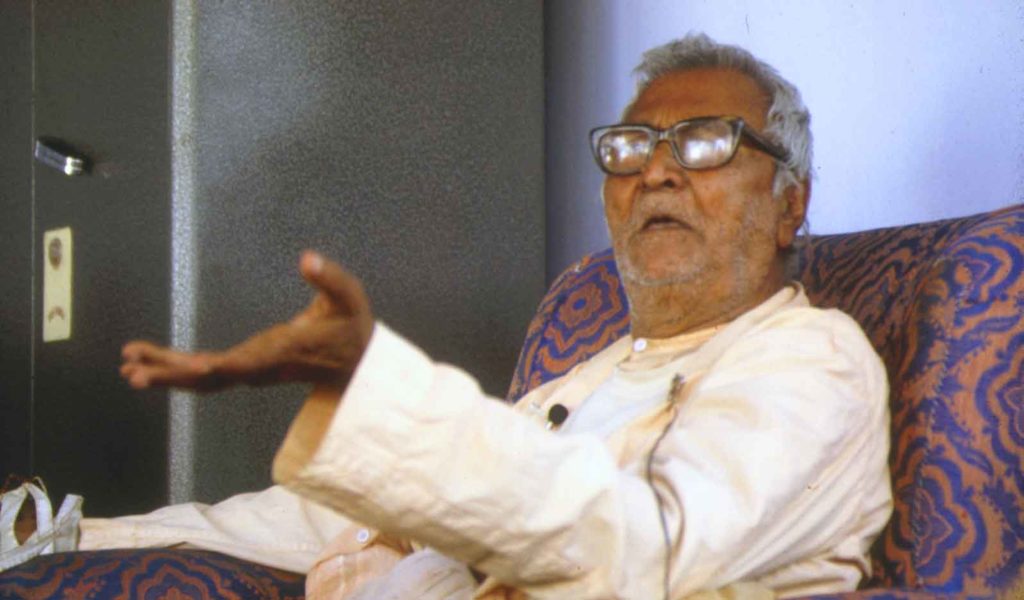Overview
'Makara Saṅkrānti' is an excerpt from a lecture given by Śrīla Śrīdhara Deva Gosvāmī Mahārāja on the occasion of Makara Saṅkrānti, the day of Śrī Caitanya Mahāprabhu's acceptance of sannyāsa, on January 14th 1984.
On this day, early in the morning, Mahāprabhu crossed the river by swimming at three o’clock or so, and ran towards Katwa. It was winter season, but He had no care for the cold. There was so much heat in His body and mind – on one side by the viraha, separation of Kṛṣṇa, and on another side by the duty of preaching to the world about devotion to Kṛṣṇa. The call of that duty actuated Him to get out of Navadvīpa and to distribute to the public love of Lord Kṛṣṇa throughout the length and breadth of the world. He cared for nothing else, He was simply running, feeling vipralambha for Kṛṣṇa. The call of Kṛṣṇa made everything else tasteless.
So much heat is created for the national cause. There are so many atomic bombs, so many soldiers ready to sacrifice their life for the national interest. How small is this mortal prosperity? What does it mean? It is trifling; it is nothing. What sort of energy should we collect for our eternal wealth? Such a high degree of welfare is to be distributed to all – to get back to their own home – to take these misguided people towards their sweet home. That call of duty arose in the mind of Mahāprabhu, “All these vagabonds should be taken to their own home and their guardian.”
They all should be taken to their home. They are wandering like so many beasts in the jungle without knowing what is good and what is bad, always engaged in competition and biting one another. They say they are civilised? Jungle animals are biting one another and trying to live at the cost of other fellow members of the jungle – as humans, more efficiently, they are following the same program. At the cost of other nations, they want to fight. What is this? It is a civilised jungle! Then what is civilisation? Civilisation loses its meaning. Civil means gentle, but is this gentleness? They are proud that they are doing things as a body. If jungle habits can be performed in the name of nationalism, then it is justified. It is all foolishness.
A half-truth is worse than a falsehood. Misguided help is much more dangerous. That means directing ones attention towards the wrong thing. Vedāśraya nāstikya-vāda bauddhake adhika – if we preach atheism in the name of religion, that is more dangerous than an ordinary straight atheist. So in the name of civilisation, we are doing things that are shameful to an animal of the jungle. Is giving food, clothing and so-called education to the public a very good thing? No! It is more important to take them home. That is what is necessary. There is an expression, ‘home comfort.’ Home comfort is very sweet. Home means our mother, father and so many affectionate relatives – they know the real necessity of their child. The child may not know, but the home knows what is his real interest.
Unconsciously the atmosphere will come render real help to us to guide us towards our home; back to God and back to home. We are all wanderers in the streets. It will collect us and to take us home. That was the duty of Mahāprabhu.
By hook or by crook, by any means, take them home. The child may not know. He may be crazy. He may run this way or that way but not towards home. And that is the problem. That makes the case complex. Otherwise it would be very simple. The responsibility is on the guide. And according to the guide’s capacity, the real effect comes to help him. That is a special capacity and also the delegation of the Lord, both combined makes the specific characteristic in the ācārya.
‘Rank is but the guinea stamp, man is the gold.’ The rank is one thing and the man is another. When his inner capacity and the delegation are combined, that is effective. The combination of the personal characteristic of the teacher and also the delegated power of the Lord produces the desired result. Mahāprabhu recommended Rūpa Gosvāmī to Svarūpa Dāmodara, “He is the fittest person to deal with the devotional scriptures. I have delegated My ability to him.” He is requesting Svarūpa Dāmodara also, “Whatever you have got, please transfer to him. He is a very worthy person. He can manage it and he can distribute it very well. He will produce it in a very befitting way and he will prepare and distribute this devotional scripture.”
So this day of the year was the last day that Mahāprabhu stayed with His family. In the afternoon He met many of His friends and appealed to them fervently to take to kṛṣṇa-nāma. “In every engagement, try to take Kṛṣṇa always with you. Eating sleeping, working – whatever you are physically engaged in, go on with the consciousness of Kṛṣṇa.
Then, by the end of the night, He left Navadvīpa. After five years He came back but did not enter His home. He only approached the front of His house and cast a glance towards the door. We are told that Viṣṇupriyā Devī, wearing a very dirty cover around her body, fell flat at His feet. Mahāprabhu Śrī Caitanyadeva could understand that it must be her and He took off His sandals. “Try to remove your pain of separation with the help of these two sandals.” Then He went away. Those wooden sandals, we are told, are still on the throne of this Viṣṇupriyā temple here in Navadvīpa. Those very old wooden sandals are still shown there and Viṣṇupriyā Devī used to worship them, five years after He took sannyāsa.
Then Mahāprabhu moved towards Vṛndāvana via Rāmakeli, and after accepting Rūpa-Sanātana, He came back again to Śāntipura and from there traveled to Purī. From Purī He went via Benares to Vṛndāvana.
This month of Pauṣa is extremely cold, but Mahāprabhu passed the whole month in Vṛndāvana, visiting different places of kṛṣṇa-lila. Then at the beginning of the month of Māgha, He came to take bath in Prayāga where he met Svarupa Dāmodara and Śrī Rūpa. For nearly a fortnight He stayed there and educated Rūpa in rāga-bhakti. Then Rūpa asked to go to Vṛndāvana and he was entrusted with some duties.
Then Mahāprabhu came to Benares and met Sanātana. For two months He lived there and instructed Sanātana in an elaborate way. Benares was also the capital of the māyāvādīs, and He met their leader and converted him. Then Mahāprabhu went back to Purī.
Twenty-four years of His life He was in Navadvīpa, and for another six years He toured different parts of India and the other eighteen years He stayed in Purī. During the first six years in Purī He used to meet with so many devotees, and then during the last twelve years He almost cut off His connection with the public and engaged Himself deeply in the cultivation of the mood of separation – vipralambha. For a full twelve years He engaged in the different mental stages of Rādhārāṇī – that deep and fiery separation was depicted for twelve years. Rāmānanda Rāya and Svarūpa Dāmodara were His very close assistants. All day and night Svarūpa Dāmodara attended Him with some of His other friends. Sometimes Mahāprabhu would rub His face on the wall, “I cannot tolerate this separation!”
In this way, He would sometimes run to the sea, or He would sometimes jump into a thorny plain in intense restlessness due to the separation from Kṛṣṇa. That was depicted in the last stages of His līlā. Gaura-haribol!
Related Articles
- 📚 Prema Dhāma Deva Stotram Series Index
- Śrī Sarasvatī Saṅlāpa (A Discourse by Sarasvatī Ṭhākura) by Śrīla Bhaktisiddhānta Sarasvatī Ṭhākura
- Śrī Gaura ki Vastu? (Who is Sri Gaura?) by Śrīla Bhaktisiddhānta Sarasvatī Ṭhākura
- The ‘Vṛndāvana Express’ and the ‘Navadvīpa Special’ by Śrīla Bhakti Rakṣaka Śrīdhara Mahārāja
- Our Prospect is Through Gaura-Līlā by Śrīla Bhakti Rakṣaka Śrīdhara Mahārāja
- Paṇḍita Śrī Gadādhara Gosvāmī by Śrīla Bhakti Rakṣaka Śrīdhara Mahārāja
- The Magnanimous Nature of Nityānanda Prabhu by Śrīla Bhakti Rakṣaka Śrīdhara Mahārāja
- Makara Saṅkrānti by Śrīla Bhakti Rakṣaka Śrīdhara Mahārāja
- Mahāprabhu as Rasarāja-Mahābhāva by Śrīla Bhakti Gaurava Narasiṅgha Mahārāja
- Mahāprabhu as Prabhupāda by Śrīla Bhakti Gaurava Narasiṅgha Mahārāja
- The Five Precepts of Śrī Caitanya Mahāprabhu
- Everything is by Mahāprabhu’s Grace by Śrīla Bhakti Gaurava Narasiṅgha Mahārāja
- Mahāprabhu’s Mudrā by Śrīla Bhakti Gaurava Narasiṅgha Mahārāja
- The Worship of Gaura-Gadādhara by Śrīla Bhakti Gaurava Narasiṅgha Mahārāja
- This Saṅkīrtana Movement Is the Līlā of Mahāprabhu by Śrīla Bhakti Gaurava Narasiṅgha Mahārāja
- Nityānanda Avadhūta by Śrīla Bhakti Gaurava Narasiṅgha Mahārāja
Further Reading
- 📖 Śrīman Mahāprabhura Śikṣā by Śrīla Bhaktivinoda Ṭhākura (Book)
- 📖 Śrī Navadvīpa-dhāma Māhātmya by Śrīla Bhaktivinoda Ṭhākura (Book)
- 📖 Gaurāṅga-līlā-smaraṇa-maṅgala Stotram by Śrīla Bhaktivinoda Ṭhākura (Book)
- 📖 Śrī Navadvīpa Bhāva Taraṅga by Śrīla Bhaktivinoda Ṭhākura (Book)
- 📖 Chaitanya Mahaprabhu His Life and Precepts by Śrīla Bhaktivinoda Ṭhākura (Book)
- 📖 Śrī Caitanya Upaniṣad by Śrīla Bhaktivinoda Ṭhākura (Book)
- 📖 The Essence of the Ten Foundational Principles (Daśa Mūla Niryāsa) by Śrīla Bhaktivinoda Ṭhākura (Book)
- The Non-Difference Between Śrī Gaura and Kṛṣna by Śrīla Bhaktivinoda Ṭhākura
- Prema-Bhakti and Śrī Gaurāṅgadeva by Śrīla Bhaktivinoda Ṭhākura
- The Sunrise of Eternal Dharma by Śrīla Bhaktivinoda Ṭhākura
- A dispute about Śrī Śrī Mahāprabhu by Śrīla Bhaktivinoda Ṭhākura
- A New Gaurāṅga by Śrīla Bhaktivinoda Ṭhākura
Pilgrimage with Swami Narasiṅgha – Part 7: Keśī Ghāṭa
Continuing with our pilgrimage series, this week Śrīla Narasiṅgha Mahārāja takes us to Keśī Ghāṭā where he tells us about Madhumaṅgala’s meeting with the Keśī demon, what Keśī represents, and how Śrīla Prabhupāda almost acquired Keśī Ghāṭa. Mahārāja also narrates his own experience. This article has been adapted from a number of talks and articles by Narasiṅgha Mahārāja.
Prema Dhāma Deva Stotram with the Narasiṅgha Sevaka Commentary – Verses 61-65
In verses 61 to 65 of 'Prema Dhāma Deva Stotram', Śrīla Śrīdhara Mahārāja narrates the pastime of Śrī Caitanya at Caṭaka Parvata In Purī and explains how the scriptures produced by Brahmā and Śiva are ultimately searching for the personality of Mahāprabhu who is merciful too all jīvas, no matter what their social position.
Prabhupāda Śrīla Sarasvatī Ṭhākura’s Visit to Ayodhyā
With the forthcoming observance of Śrī Rāma Navamī, we present 'Prabhupāda Śrīla Sarasvatī Ṭhākura’s Visit to Ayodhyā' written by Śrīla Bhaktisiddhānta Sarasvatī Ṭhākura Prabhupāda from The Gaudīyā magazine, Vol 3. Issue 21/ In December 1924, after visiting Benares and Prāyāga, Sarasvatī Ṭhākura visited the birth-site of Śrī Rāmācandra in Ayodhyā.
Śaraṇāgati – The Only Path to Auspiciousness
In this article, 'Śaraṇāgati - The Only Path to Auspiciousness', Dhīra Lalitā Dāsī analyses the process of śaraṇāgati (surrender) beginning with śraddhā (faith). She also discusses the role of śāstra and the Vaiṣṇava in connection with surrender.
Pilgrimage with Swami Narasiṅgha – Part 7: Keśī Ghāṭa
Continuing with our pilgrimage series, this week Śrīla Narasiṅgha Mahārāja takes us to Keśī Ghāṭā where he tells us about Madhumaṅgala’s meeting with the Keśī demon, what Keśī represents, and how Śrīla Prabhupāda almost acquired Keśī Ghāṭa. Mahārāja also narrates his own experience. This article has been adapted from a number of talks and articles by Narasiṅgha Mahārāja.
Prema Dhāma Deva Stotram with the Narasiṅgha Sevaka Commentary – Verses 61-65
In verses 61 to 65 of 'Prema Dhāma Deva Stotram', Śrīla Śrīdhara Mahārāja narrates the pastime of Śrī Caitanya at Caṭaka Parvata In Purī and explains how the scriptures produced by Brahmā and Śiva are ultimately searching for the personality of Mahāprabhu who is merciful too all jīvas, no matter what their social position.
Prabhupāda Śrīla Sarasvatī Ṭhākura’s Visit to Ayodhyā
With the forthcoming observance of Śrī Rāma Navamī, we present 'Prabhupāda Śrīla Sarasvatī Ṭhākura’s Visit to Ayodhyā' written by Śrīla Bhaktisiddhānta Sarasvatī Ṭhākura Prabhupāda from The Gaudīyā magazine, Vol 3. Issue 21/ In December 1924, after visiting Benares and Prāyāga, Sarasvatī Ṭhākura visited the birth-site of Śrī Rāmācandra in Ayodhyā.
Śaraṇāgati – The Only Path to Auspiciousness
In this article, 'Śaraṇāgati - The Only Path to Auspiciousness', Dhīra Lalitā Dāsī analyses the process of śaraṇāgati (surrender) beginning with śraddhā (faith). She also discusses the role of śāstra and the Vaiṣṇava in connection with surrender.








